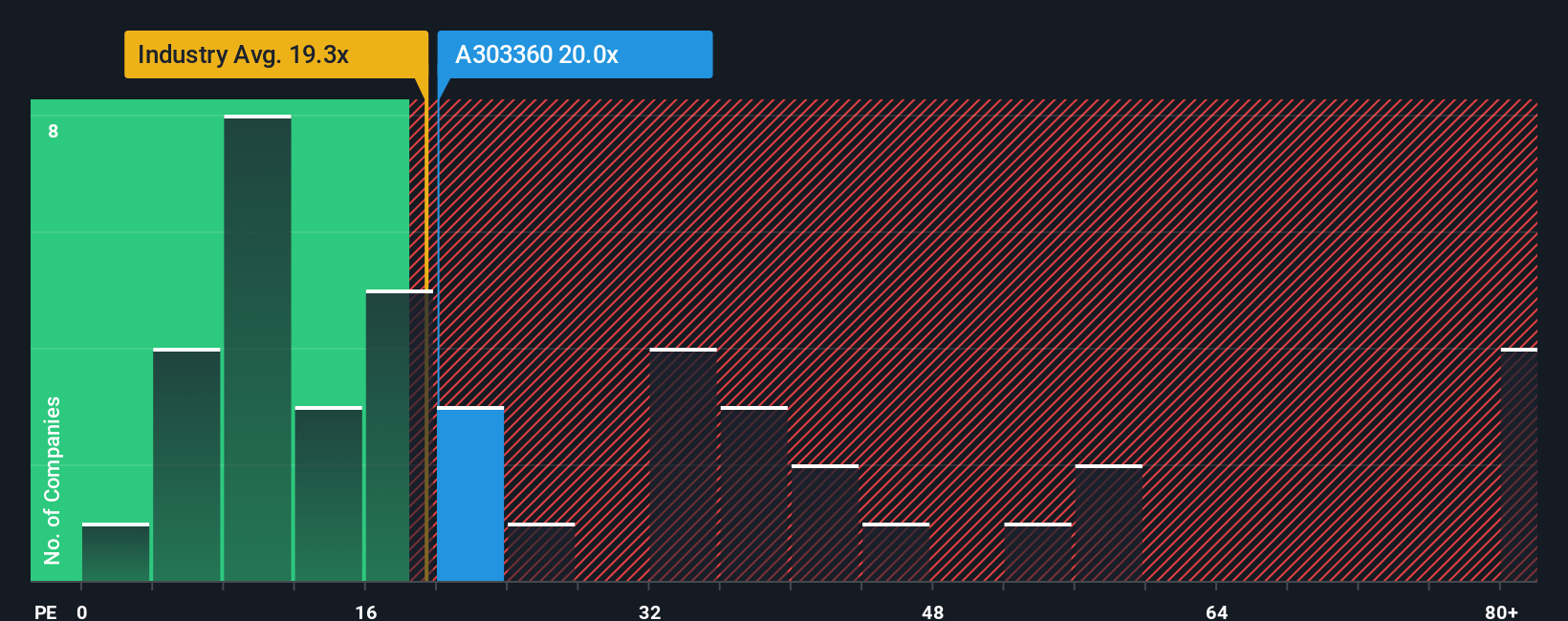- South Korea
- /
- Medical Equipment
- /
- KOSDAQ:A303360
Subdued Growth No Barrier To Protia Inc. (KOSDAQ:303360) With Shares Advancing 35%
Protia Inc. (KOSDAQ:303360) shareholders have had their patience rewarded with a 35% share price jump in the last month. The annual gain comes to 122% following the latest surge, making investors sit up and take notice.
Since its price has surged higher, Protia's price-to-earnings (or "P/E") ratio of 20x might make it look like a sell right now compared to the market in Korea, where around half of the companies have P/E ratios below 13x and even P/E's below 7x are quite common. However, the P/E might be high for a reason and it requires further investigation to determine if it's justified.
With earnings growth that's exceedingly strong of late, Protia has been doing very well. The P/E is probably high because investors think this strong earnings growth will be enough to outperform the broader market in the near future. You'd really hope so, otherwise you're paying a pretty hefty price for no particular reason.
See our latest analysis for Protia

Is There Enough Growth For Protia?
The only time you'd be truly comfortable seeing a P/E as high as Protia's is when the company's growth is on track to outshine the market.
Retrospectively, the last year delivered an exceptional 170% gain to the company's bottom line. Pleasingly, EPS has also lifted 163% in aggregate from three years ago, thanks to the last 12 months of growth. Accordingly, shareholders would have probably welcomed those medium-term rates of earnings growth.
It's interesting to note that the rest of the market is similarly expected to grow by 35% over the next year, which is fairly even with the company's recent medium-term annualised growth rates.
With this information, we find it interesting that Protia is trading at a high P/E compared to the market. It seems most investors are ignoring the fairly average recent growth rates and are willing to pay up for exposure to the stock. Nevertheless, they may be setting themselves up for future disappointment if the P/E falls to levels more in line with recent growth rates.
The Key Takeaway
The large bounce in Protia's shares has lifted the company's P/E to a fairly high level. It's argued the price-to-earnings ratio is an inferior measure of value within certain industries, but it can be a powerful business sentiment indicator.
Our examination of Protia revealed its three-year earnings trends aren't impacting its high P/E as much as we would have predicted, given they look similar to current market expectations. When we see average earnings with market-like growth, we suspect the share price is at risk of declining, sending the high P/E lower. If recent medium-term earnings trends continue, it will place shareholders' investments at risk and potential investors in danger of paying an unnecessary premium.
Plus, you should also learn about these 3 warning signs we've spotted with Protia (including 2 which are potentially serious).
You might be able to find a better investment than Protia. If you want a selection of possible candidates, check out this free list of interesting companies that trade on a low P/E (but have proven they can grow earnings).
New: Manage All Your Stock Portfolios in One Place
We've created the ultimate portfolio companion for stock investors, and it's free.
• Connect an unlimited number of Portfolios and see your total in one currency
• Be alerted to new Warning Signs or Risks via email or mobile
• Track the Fair Value of your stocks
Have feedback on this article? Concerned about the content? Get in touch with us directly. Alternatively, email editorial-team (at) simplywallst.com.
This article by Simply Wall St is general in nature. We provide commentary based on historical data and analyst forecasts only using an unbiased methodology and our articles are not intended to be financial advice. It does not constitute a recommendation to buy or sell any stock, and does not take account of your objectives, or your financial situation. We aim to bring you long-term focused analysis driven by fundamental data. Note that our analysis may not factor in the latest price-sensitive company announcements or qualitative material. Simply Wall St has no position in any stocks mentioned.
About KOSDAQ:A303360
Flawless balance sheet with low risk.
Market Insights
Community Narratives



